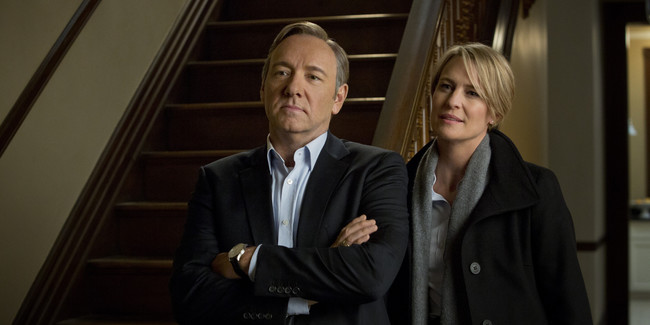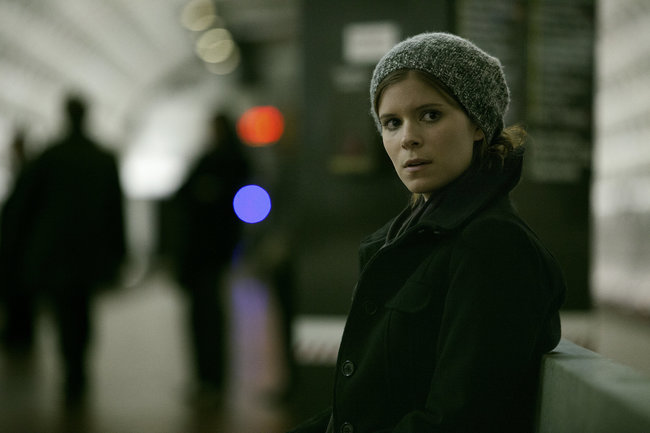House of Cards, Netflix, and the Mythologizing of Newness
- Spoiler Alert Please be advised that this article contains detailed descriptions of certain pivotal plot points in the series House of Cards.
When House of Cards premiered on Netflix in February 2013, it was met with praise and excitement. Perhaps its loudest champions were the TV critics thrilled to see the birth of a new model, an alternative to television broadcast.
How was Cards new and different from other shows? One big and evident change to the status quo was that the series didn’t really premiere at all. Rather, its first season was made available in its entirety on February 1st via the streaming site. In a Forbes article, Greg Satell suggested that House of Cards was “the first major TV show to completely bypass the usual television ecosystem of networks and cable operators” … “The game has changed,” Satell told us. And to some extent it had. Where the VCR, DVD boxed sets, and TiVo were time-shifting devices, allowing us to delay our viewing experience, Cards removed the temporal boundaries of television. To a point. Episodes obviously had a running time, we couldn’t start watching until the official release date, and we had to wait a year for Season 2. Nevertheless, billed as the first “Netflix Original Series,” House of Cards was marketed, and indeed received, as a radically new player in television content delivery.
But where has that excitement for novelty gone? Todd Spangler at Variety suggests that, as ratings for Cards and other Netflix originals like Orange is the New Black dip, the “novelty factor” is in fact wearing off. It is quite difficult to gauge how successful the Netflix model may be, as it does not, for obvious reasons, rely on a consistent audience showing up week after week in order to be profitable. What can be gauged is how Netflix chooses to tell its stories, and here House of Cards is a fascinating case study of the rise and fall of novelty.
In Season 1, Frank Underwood (Kevin Spacey), an American congressman and house majority whip, is overlooked by the new president for promotion to Secretary of State. Emboldened to fight his way to the top, Frank enlists the help of a young reporter, Zoe Barnes (Kate Mara). In exchange for giving her exclusive scoops, Frank has access to a major newspaper, The Washington Herald, to sway public opinion in his favour.
Zoe’s character, a young and ambitious reporter, consistently butts heads with her editor, Tom Hammerschmidt (Boris McGiver). This conflict, between new and old, progressive and conservative, hip and out of touch, is indicative of the show’s broader engagement with new content platforms and its portrayal of a tension between print and web media - standing in for traditional television and online streaming respectively. Episode 5 brings this tension to the fore. After Zoe is fired from the Herald, the paper’s owner, Margaret Tilden (Kathleen Chalfant) calls Hammerschmidt to her home to fire him. She first gives him the chance to explain himself, and the exchange that follows - Hammerschmidt’s failed attempt to convince her of his value to the paper and Zoe’s lack thereof - perfectly allegorizes Netflix’s project:
Tilden: We’ve been through this, Tom. The paper’s operating at a loss - we need people like Zoe.
Hammerschmidt: I’m very aware of how much we’re hurting, Margaret: staff reductions, dip in circulation - each one of those faces and every subscriber we lose, they keep me awake at night. Now, I won’t argue the business side of things…it’s neither my place nor my area of expertise. But know this: Zoe Barnes, Twitter, blogs, enriched media…they’re all surface. They’re fads. They aren’t the foundation this paper was built on, and they aren’t what will keep it alive. We have a core readership that thirsts for hard news. Those are the people I work eighty hours a week for. I won’t be distracted by what’s fashionable.
Importantly, this is the last time that we see Hammerschmidt in the entire season, whereas Zoe remains a central character. In a sense, Hammerschmidt is right: Zoe Barnes will not keep the Herald alive, she will move on to better things. But he is suggesting something far more consequential during this exchange, namely that the future of journalism depends on a return to something traditional. What that something might be is not entirely clear, but it is not to be found primarily online.
After being fired, Zoe accepts a job at Slugline, a popular online news outlet. She is the future of the show, and, by extension, Slugline is the future of journalism, says House of Cards. Hammershmidt’s attempts to save the paper are a response to growing competition on new platforms. Television has been similarly affected by the advent of DVDs and online streaming as alternatives to traditional broadcast. While Cards was telling us that online journalism will win out in the end, Netflix and the show’s reviewers believed that a new age of television production and exhibition had begun.
Perhaps this new age had indeed begun. It certainly seems to exist, thrive even. New Netflix series continue to pop up, with big name casts and producers, and more than a few favourable reviews. Amazon and Hulu have similarly produced original content. We seem to have seen, not a transition, but certainly a rise in new media television. Excited about its own novelty, House of Cards constructed a complex narrative that mirrored its own status as the cool new kid. Zoe and Slugline were beautiful stand-ins for House of Cards and Netflix.
But then, on February 14th, 2014, Season 2 of Cards was released. In its first episode, Frank, in one of the series’ most shocking moments to date, threw Zoe in front of a speeding train. Seeing her as a liability to his own political aspirations, he put a permanent end to her inquisitiveness - and to a rather important subplot. With Zoe’s death, we have lost our connection to Slugline. The focus has been recentred on Frank. As Frank fought his way closer to the American presidency, the series took on a rather conservative tone. Partisan politics and male rivalries had centre stage, while a sub-plot about digital surveillance cast a dark shadow over technology in general.
In one particularly notable scene in the season’s final episode, Frank digs up an old Underwood typewriter to write a letter to the president, blowing dust off of this antique writing instrument, tying Cards to decidedly outdated media.
Obviously, this comparison has its limits. The death of Zoe surely does not predict the death of the Netflix original series, nor should we assume that the streaming service has lost faith in itself. It may also be worth noting the many progressive features of the season: a remarkably sophisticated discussion of systemic sexual violence, the promotion of a military woman to Frank’s old job as majority whip, and a rather unexpected (if perfectly appropriate) offscreen sexual encounter between Frank, his wife Claire (Robin Wright), and their favourite Secret Service agent, Meechum (Nathan Darrow).
What this shift in thematic concerns suggests is that the novelty factor has indeed worn off. Initially enamored of its own newness, House of Cards wore novelty on its sleeve, building a new media manifesto around Zoe.
So why drop this analogy in Season 2? Perhaps because we are all convinced. Perhaps because we are not so interested in novelty anymore. Perhaps because Netflix has won. Not in the sense that television has been ousted, but rather that Netflix has an assured place in the broader landscape. For a shockingly brief time, debate raged over whether online-only television would ever work, and now, two seasons in, it’s just another part of business as usual.
Works Cited
- Satell, Greg. “What Netflix’s ‘House of Cards’ Means for the Future of TV.” Forbes Online, 4 April 2013.
- Spangler, Todd. “Has Netflix’s Originals ‘Novelty Factor’ Worn Off?” Variety, 11 November 2014.

